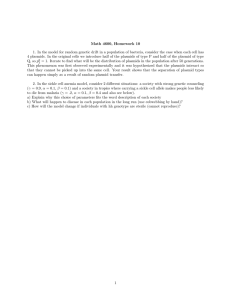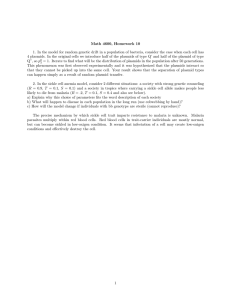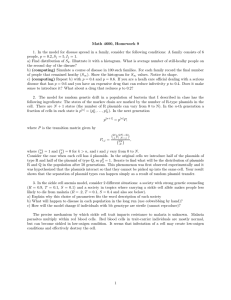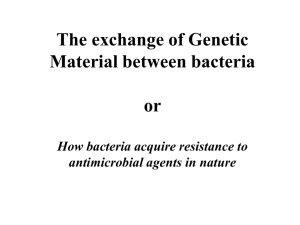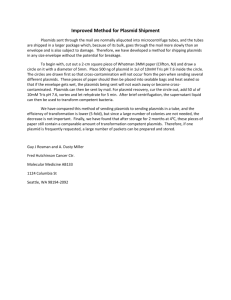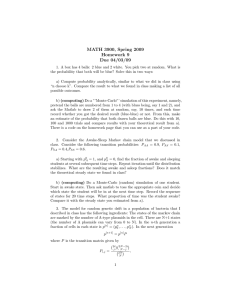REVIEW Why Do Bacterial Plasmids Carry Some Genes and Not
advertisement
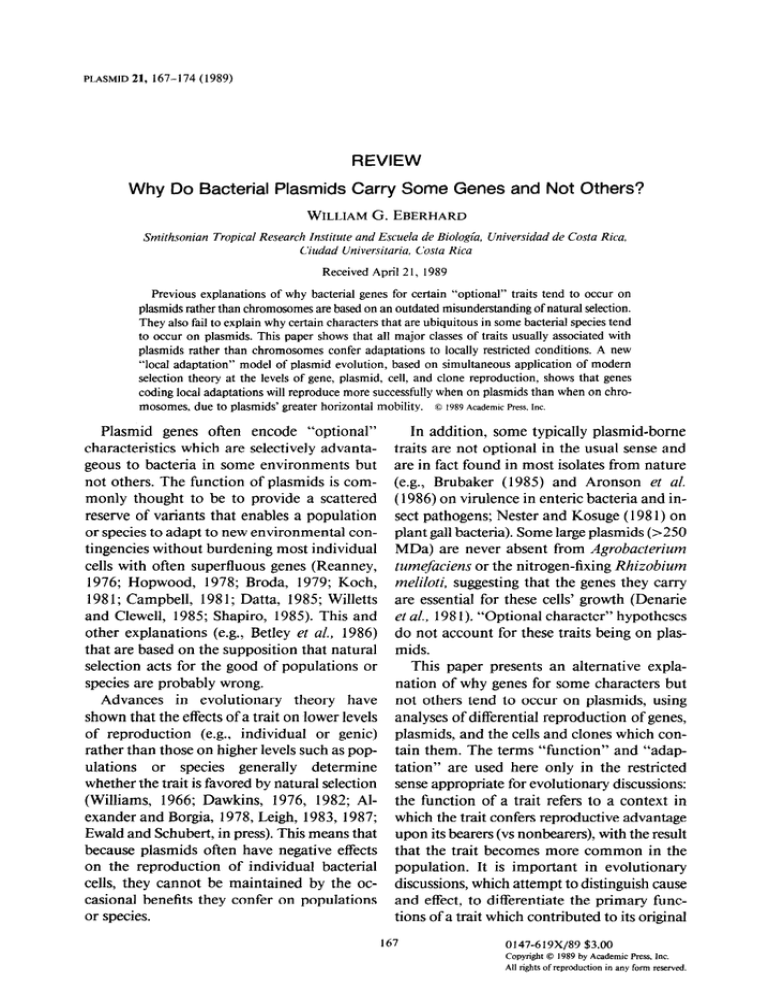
PLASMID 21, 167-174 (1989) REVIEW Why Do Bacterial Plasmids Carry Some Genes and Not Others? WILLIAMG.EBERHARD Smithsonian Tropical Research Institute and Escuela de Biologia, Universidad de Costa Rica, Ciudad Universitaria, Costa Rica Received April 2 I, 1989 Previous explanations of why bacterial genes for certain “optional” traits tend to occur on plasmids rather than chromosomesare basedon an outdated misunderstandingof natural selection. They also fail to explain why certain charactersthat are ubiquitous in some bacterial speciestend to occur on plasmids. This paper shows that all major classesof traits usually associated with plasmids rather than chromosomes confer adaptations to locally restricted conditions. A new “local adaptation” model of plasmid evolution, based on simultaneous application of modern selection theory at the levels of gene, plasmid, cell, and clone reproduction, shows that genes coding local adaptations will reproduce more successfullywhen on plasmids than when on chromosomes, due to plasmids’ greater horizontal mobility. 0 1989 Academic press, Inc. Plasmid genes often encode “optional” characteristics which are selectively advantageous to bacteria in some environments but not others. The function of plasmids is commonly thought to be to provide a scattered reserve of variants that enables a population or speciesto adapt to new environmental contingencies without burdening most individual cells with often superfluous genes (Reanney, 1976; Hopwood, 1978; Broda, 1979; Koch, 1981; Campbell, 1981; Datta, 1985; Willetts and Clewell, 1985; Shapiro, 1985). This and other explanations (e.g., Betley et al., 1986) that are based on the supposition that natural selection acts for the good of populations or speciesare probably wrong. Advances in evolutionary theory have shown that the effectsof a trait on lower levels of reproduction (e.g., individual or genie) rather than those on higher levels such as populations or species generally determine whether the trait is favored by natural selection (Williams, 1966; Dawkins, 1976, 1982; Alexander and Borgia, 1978, Leigh, 1983, 1987; Ewald and Schubert, in press).This meansthat because plasmids often have negative effects on the reproduction of individual bacterial cells, they cannot be maintained by the occasional benefits they confer on populations or species. In addition, some typically plasmid-borne traits are not optional in the usual senseand are in fact found in most isolates from nature (e.g., Brubaker (1985) and Aronson et al. ( 1986) on virulence in enteric bacteria and insect pathogens; Nester and Kosuge ( 1981) on plant gall bacteria). Somelarge plasmids (>250 MDa) are never absent from Agrobacterium tumefaciens or the nitrogen-fixing Rhizobium meliloti, suggesting that the genes they carry are essential for these cells’ growth (Denarie et al., 1981). “Optional character” hypotheses do not account for these traits being on plasmids. This paper presents an alternative explanation of why genes for some characters but not others tend to occur on plasmids, using analysesof differential reproduction of genes, plasmids, and the cells and clones which contain them. The terms “function” and “adaptation” are used here only in the restricted senseappropriate for evolutionary discussions: the function of a trait refers to a context in which the trait confers reproductive advantage upon its bearers(vs nonbearers),with the result that the trait becomes more common in the population. It is important in evolutionary discussions,which attempt to distinguish cause and effect, to differentiate the primary functions of a trait which contributed to its original 167 0147-619X/89 $3.00 Copyright 0 I989 by Academic Press, Inc. All rights of reproduction in any form reserved. 168 REVIEW spread and its maintenance via differences in the reproduction of bearers and nonbearers, from second-order effectswhich are incidental consequences of the trait’s becoming established (Williams, 1966;Gould and Vrba, 1982; Vermiij, 1987). This distinction between function and effect has not been made carefully in some previous discussions of the evolution of plasmids and other mobile elements. To use an example that has generated recent controversy, when transposons and insertion sequencespropagate themselves within a genome, they often generate new gene combinations and mutations; these are occasionally advantageous and have undoubtedly influenced the course of evolution in different groups. But this does not justify claiming that the generation of new combinations (which usually reduce their bearer’s reproduction) is their function (Campbell, 1981; Syvanen, 1984) (see Charlesworth, 1987). Just because a consequence of a trait is to increase certain kinds of change does not mean that the function of the trait is to produce these changes. general classesof traits tend to be coded on plasmids rather than chromosomes: “plasmidselfish” characters such as conjugation, mobilization, inhibition of bacterial cell division, and plasmid surface exclusion and partitioning, which promote the survival and replication of the plasmid as a unit; and optional characters such as resistance to antibiotics, heavy metals, and other poisons, virulence, metabolism of unusual substrates, plant gall formation, root nodulation and N fixation, and bacteriocins (Broda, 1979), characters which favor the survival and reproduction of the entire cell in certain environments. The reason plasmid-selfish characterstend to occur on plasmids is clearly becausethey favor plasmid (rather than chromosome) reproduction; they make plasmids resembleindependent organisms in some respects(Novick, 1980; Salyers, 1984; Datta, 1985). These traits set the “rules of the game” for analysesof why other, non-plasmid-selfish genes also tend to occur on plasmids. The question of why optional genestend to occur on plasmids is posed here at the level of GENERAL CONSIDERATIONS gene reproduction, but its answer involves Bacterial genesmove between plasmids and analysesat three higher levels of reproduction: chromosomes (Rowbury, 1977; Hart1 and plasmids vs chromosomes within cells; cells Dykhuizen, 1984),as well as from one plasmid that do or do not have plasmids in addition to another (Godwin and Slater, 1979; Broda, to their chromosomes; and clones with or 1979). Given common population sizes and without plasmid-carrying cells. The reproducrates of interchange (e.g., Lewin, 1977), and tive advantages or disadvantages of a given the probably very long evolutionary lives of gene at these different levels are of course to many genesin bacteria, it is probable that most some extent synonomous. But some traits can bacterial geneshave been in both plasmids and increase the reproduction of units at one level chromosomes repeatedly during their evolu- while decreasing reproduction at others. Hitionary lives. This must be especially true for erarchical living systems show “emergent” genesassociatedwith insertion sequencesand concerns at different levels (Buss, 1987),aswell for bacterial specieswith F-like plasmids which as conflicts of reproductive interest between integrate into the chromosome. Chromosomes different levels (Buss, 1987; seealso Alexander and plasmids thus share, to a substantial de- and Borgia, 1978; Eberhard, 1980; Cosmides gree, a common genepool. To determine why and Tooby, 1981; Leigh, 1987). Thus considsome types of genes and not others tend to eration of possible synergisms and conflicts occur on plasmids, one must ask why some between selection at all four levels is necessary geneshave done better (made more copies of to understand plasmid evolution. Previous themselves) when located on plasmids than analyseswhich did not carefully separateand when on chromosomes. weigh advantagesat these different levels (e.g., Bacterial genesare not randomly distributed Reanney, 1976; Koch, 1981; Campbell, 1981) between chromosomes and plasmids. Two produced confusing results. REVIEW NEGATIVE EFFECTS CELL AND CLONE OF PLASMIDS REPRODUCTION ON Plasmids have been thought to be to some extent parasitic on the bacteria in which they reside, reducing the reproductive potential of their carriers asa result of promoting their own maintenance and propagation (Salyers, 1984; Datta, 1985). Most evidence supporting these ideas is of two types: experimental demonstrations that plasmid-carrying strains usually lose in competition with similar bacteria when under more or less artificial conditions (Anderson, 1974; Godwin and Slater, 1979; Melling et al., 1977;Zi.ind and Lebek, 1980;DuvalIflah et al., 1981; Fretter et al., 1983; Scholz et al., 1985); and demonstration that bacteria found in natural environments lacking conditions for which plasmid geneswould confer special advantages(e.g., environments lacking antibiotics) tend to lose or to lack plasmids carrying those genes (Grabow et al. (1974), Koch (1981), and Hughes and Datta (1983) on antibiotic resistance; Robinson and Tuovinen ( 1984) on heavy metal tolerance; Dowling and Broughton ( 1986) on root nodulation; see also Cavalier-Smith (1985) on superfluous genes in general). The combination of these lines of evidence suggeststhat plasmids per se often have negative effectson bacterial fitness. PLASMIDS AND LOCAL ADAPTATIONS: A NEW MODEL Although rates of horizontal transfer vary between plasmids and in different bacteria (Broda, 1979),geneson plasmids are generally more likely to be transferred horizontally and thus cohabit cells with different chromosomal and plasmid genes than those on chromosomes (Wheelis, 1975; Lewin, 1977). The more frequent horizontal transmission of plasmid genesresults in a wider variety of genetic settings in which they can act, giving the plasmid genesmore of the selectiveadvantages of sexual reproduction (Felsenstein, 1974; Williams, 1975; Maynard Smith, 1978; Leigh, 1987). One expected result is that plasmid geneswill be able to evolve more rapidly than 169 chromosomal genes in response to environmental changes. In addition, genescoding for adaptations to variations in environmental conditions that occur only sporadically in time or spaceshould reproduce more rapidly when on plasmids. Arguments supporting this claim will be developed using antibiotic resistance as an example, then extended to other functions. Antibiotics are generally restricted to the immediate vicinity of antibiotic-producing organisms such as certain soil fungi, actinomycetes, and other bacteria (Broda, 1979; Martin and Demain, 1980) and, recently, to sites of modern medical treatment and industrial antibiotic production. Several factors contribute to the maintenance of a locally advantageous character like antibiotic resistance on plasmids rather than chromosomes. Consider two otherwise equal strains of bacteria carrying an antibiotic resistancegene,one with the gene on a chromosome and the other with the gene on a plasmid. The resistance gene produces a phenotype that has a selective advantage only in the conditions that prevail in certain locations where antibiotic is present. At such sites both strains will be favored over bacteria lacking resistance genes, but the resistance geneson plasmids will outreproduce those on chromosomes for several reasons: 1. New bacterial strains colonizing the site are unlikely to carry the resistance gene (e.g., Broda, 1979; Koch, 1981; Hughes and Datta, 1983). These new bacteria, which are more likely to lack a plasmid of the incompatibility type that carries the resistance gene will thus be more likely to be receptive to horizontal transmission and more likely to benefit from the plasmid-coded local adaptation. Thus advantagesat both the cell and the plasmid levels would make a resistance gene on a plasmid able to propagate itself more rapidly than if it were on a chromosome. 2. The resistancegene on plasmids will inhabit cells containing a much greater variety of other chromosome and plasmid genomes than will the geneson chromosomes. Plasmid geneswill thus have a greater likelihood of as- 170 REVIEW sociating themselves with superior genes for other functions and winning out in competition between clones. This could be an important advantage if sequential replacements of clones such as those observed in intestinal Escherichia coli (Caugant et al., 1981) are common modes of evolution in bacteria. 3. Some antibiotic resistance genes on plasmids are amplified quickly when needed and rapidly eliminated when not needed (Broda, 1979; Clewell, 1981), conferring increasedfitness on the cells and clones carrying them. The resistancegene on transposon Tn9 is amplified more readily when the gene is on a plasmid (fewer other gene products are needed) than when it is on a chromosome (Mahajan et al., 1985). This expected advantage will be especially strong when gene expression is constitutive, as is generally true for resistance plasmids in gram-negative bacteria (Burman, 1977). 4. There is an additional positive feedback in the advantages to local adaptation genes of being on plasmids, since the advantage of being on a plasmid is greatly increased if the plasmid already carries another gene or genes coding for adaptations to the same or similar local conditions. The tighter the association between the different conditions for which the different genes confer advantages, the greater this additional linkage advantage. Even if the conditions are very weakly associated, a second gene could benefit from hitchhiking along with another, at least if the rate of recombination is low enough. When different genes both confer adaptations to the same conditions, the “piling on” advantage could be very powerful and probably accounts for the remarkably rapid additions of genesto some resistance plasmids such as the hospital-associated plasmid that added four antibiotic resistance genes and grew from 45 to 65 MDa in the space of only about 10 years (Datta, 1985), and the mercury resistancetransposon on the plasmid CS229 in hospitals which also rapidly added multiple antibiotic resistance genes(Robinson and Tuovinen, 1984). of general usefulness (“housekeeping genes”) to not occur on plasmids (Koch, 1981). Horizontal transmission will not confer the reproductive advantages just mentioned on genes whose products are useful in all potentially habitable environments. COMMON PLASMID FUNCTIONS LOCAL ADAPTATIONS AS Some other plasmid functions in addition to antibiotic resistanceclearly seemto be local adaptations: the ability to metabolize or otherwise resist heavy metals and other poisons, which probably usually have patchy distributions (Robinson and Tuovenin, 1984); virulence charactersin facultative pathogens;and the ability to degrade unusual substrates (Wheelis, 1975; Broda, 1979; Ghosel et al., 1985).Some plasmid functions, however, such as virulence in obligate pathogens, plant gall, and nodule formation and N fixation, and production of bacteriocins do not appear to fit this characterization. I will argue, nevertheless, that they too are only locally adaptive. I. Virulence Factors At first glance, virulence (that subset of characters which is useful in establishing infections by dealing with conditions associated with the host, but which do not have any known use to the bacterium in other contexts) does not seemto be a local adaptation in bacteria which are obligate pathogens. For instance, those bacteria which cause invasive diseasesin animals generally grow poorly or not at all outside their hosts (Bulla et al., 1975; Brubaker, 1985; Aronson et al., 1986), and virulence factors tend to be present throughout these bacterial species(Bulla et al., 1975; Brubaker, 1985). Closer examination shows, however, that these virulence factors probably confer only local advantages. Many of these bacteria are not host-specific, and some attack a wide spectrum of hosts. Different host species appear to harbor disease bacteria with slightly different virulence-codThe sametype of reasoning explains the re- ing plasmids. For example, there are “literally verse side of the coin-the tendency for genes thousands of” strains of insecticidal Bacillus REVIEW 171 invading the host speciesfrom which they were originally isolated. Different sites on the same host plant may also require different adaptations, and some Agrobacterium plasmid mutants infect certain sites more effectively than others (Gheysen et al., 1985). Some plasmids of both genera even show specificities for certain varieties or cultivars of the host plant species (Nester and Kosuge, 1981; Denarie et al., 1981). Plasmids of the less-studied Pseudomonas savastanoi code a diversity of cytokinins; since such diversity is associatedwith host specificity in other groups (seeAronson et al. (1986) on B. thuringiensis; Cavalieri et al. (1984) on hemolysin plasmids; Panopoulos and Peet( 1985) on other plant pathogens), this suggeststhat these plasmids may also may confer host-specific adaptations. The host specificity of plasmid functions suggests a locally adaptive selective regime similar to that just described for virulence factors. Mutualism between clones may also operate, as infections by larger numbers of Rhizobium are more likely to produce nodulation (Dowling and Broughton, 1986). In addition, both gall and root nodule bacteria have an alternate habitat (free in the soil outside of host plants). Different strains differ in their abilities to survive and compete with other bacteria in different soil types, and plasmid genes are known to be responsible for some of these differences (Dowling and II. Plant Gall and Nodule Factors Broughton, 1986; see also Moore and CookThe better-studied genera Agrobacterium sey, 1981, on Agrobacterium). In sum, charand Rhizobium are similar to the pathogens acters promoting invasion and intraplant rejust discussed, as host specificity is known to production are clearly adaptations for life in be encoded on plasmids. The two or three the local vicinity of certain plants. Agrobacterium species(Elkan, 1981) produce tumors in 142 genera in 61 families of plants III. Bacteriocins (Lippincott and Lippincott, 1975), while the As a group, bacteriocin plasmids are relatwo Rhizobium groups (Elkan, 1981) also grow tively common, at least in some bacteria: 10 in a wide variety of plants (> 1130 speciesin of 32 E. coli isolates collected prior to the anthe families Leguminosae and Ulmaceae) tibiotic era produced bacteriocins, and this (Stowers, 1985).Not all bacterial strains invade may be an underestimate (Hughes and Datta, all host speciesequally well, and plasmids of- 1983). If bacteriocin plasmids are so common ten code this host specificity (Nester and Ko- and are advantageous in competition with suge, 1981; Moore and Cooksey, 1981; Ghey- other closely related bacteria (Broda, 1979) sen et al., 1985; Dowling and Broughton, could they still represent only local adapta1986). Strains tend to be particularly good at tions? thuringiensis and its relatives, and “no single isolate is active against all pest species” (Aronson et al., 1986); different plasmid-coded protoxins are active againstdifferent insect groups. Different hemolysin geneson plasmids in vertebrate pathogens also have different levels of toxicity in different host species(Gaastra and van Graaf, 1982; Welch and Falkow, 1984; Goebel et al., 1985). In enterotoxic E. coli that causediarrhea in man and farm animals, plasmid-coded fimbrial antigens that mediate adhesion to the intestinal epithelium differ and are host-specific (Willshaw et al., 1985). These different virulence factors thus represent adaptations to taxonomically “local” conditions. Different strains of bacterial pathogens of plants also often have limited host ranges,and in some casesit is known that host specificity is coded on plasmids (Panopoulos and Peet, 1985). It is also possible in both plants and animals that different individuals of the same host speciesmay require different adaptations by pathogens. A further possible advantage of horizontal transmission of virulence factors occurs at the level of mutualisms between clones. Some host defenses are more likely to be overcome by massive invasion than by small numbers of disease organisms (e.g., Hirano and Upper, 1983). Horizontal transmission of virulence factors could raise the chances of successful infection for all invading bacteria. 172 REVIEW The probable answer is yes, since most bacteriocins are degraded by proteases such as those common in important habitats like the vertebrate intestine and dental plaque (Hardy, 1975). Bacteriocins are also less effective in anaerobic conditions such as those of vertebrate intestines. These same bacteriocins are more active in urine, blood, and the peritoneal cavity (Hardy, 1975). Thus the advantage of having bacteriocin plasmids probably depends to a substantial degree on local conditions. Modulation of bacteriocin production suggeststhat the poisons are costly and only locally useful. When densities of cells containing baceriocinogenic Co1 factors are increased or the cells are starved of thymine, the percentage of cells producing toxin in large quantities rises from 0.01 to 1% (Broda, 1979). In Erwinia uredovora bacteriocin production is correlated with gene amplification, and noninduced stagesshow only low amplification (Thiry et al., 1985). DISCUSSION The goal of this article is not to explain all plasmid characters, but to understand why certain subsets of bacterial genomes-genes that confer local rather than general adaptations-tend to occur on plasmids rather than chromosomes. Excluded from consideration were the large number of cryptic plasmids as well as other plasmid genes with a variety of other phenotypic effects (e.g., Koyama and Yura, 1975; DiJoseph et al., 1973; Chernin and Mikoyan, 1981). Some plasmid-coded traits, such as uv resistance in Streptococcus (Clewell and Gawron-Burke, 1986) may also prove to be local adaptations. Some cryptic plasmids may also be found to carry genesfor local adaptations, while others may be parasitic. Levin and Stewart ( 1980) and Caugant et al. ( 1981) argue that most cryptic plasmids, and especially nonconjugative cryptic plasmids, cannot be maintained unless they code for selectively advantageousfunctions, but this may not be true for some transposons (Biel and Hartl, 1983). The local adaptation theory was presented above in terms of extreme cases(local vs gen- era1adaptations), but these are obviously the ends of a continuum. Genes conferring advantageswhich are lesslocally restricted would derive lessadvantage from being on plasmids. And if a given plasmid becamemore and more common, the disadvantagesto a housekeeping gene of being on that plasmid would gradually decrease. Eventual transfer of one or more such genes could tend to “fix” the plasmid, making it subject to more chromosome-like selection, This may have occurred for a large Rhizobium plasmid (Denarie et al., 1981). Plasmid-selfish selection is also obviously important, and some plasmids may simply be parasites, carrying no genes useful to the cell (Datta and Hughes, 1983;Salyers, 1984;Datta, 1985). The sheernumbers of plasmids and the variety of genes they carry suggest that still other explanations may be needed. ACKNOWLEDGMENTS It is a pleasure to thank my colleague and molecular guru Pedro Leon for patient and thoughtful answers to many unconventional and naive questions. Discussions with Allen Herre, Egbert Leigh, Stanley Rand, and Mary Jane West-Eberhard helped clarify several points. Paul Ewald, E. G. Leigh, P. Leon, R. Novick, and M. J. WestEberhard made detailed comments on the manuscript. A conversation with Paul Ewald provided the inspiration for this project. S.T.R.I. librarians Angel Aguirre and Roberto Sarmiento helped me obtain references.The Vicerrectoria de Investigacibn of the Universidad de Costa Rica provided financial support. REFERENCES ALEXANDER,R. D., AND BORGIA,G. (1978). Group selection, altruism, and the levels of organization of life. Annu. Rev. Ecol. Syst. 9, 449-474. ANDERSON,J. D. (1974). The effect of R factor carriage on the survival of Escherischia coli in the human intestine. J. Med. Microbial. 7, 85-90. ARONSON,A. I., BECKMAN,W., AND DUNN, P. (1986). Bacillus thuringiensis and related insect pathogens.Microbiol. Rev. 50, l-24. BETLEY, M. J., MILLER, V. L., AND MEKALANOS,J. J. (1986). Genetics of bacterial endotoxins. Annu. Rev. Microbial. 40, 577-605. BIEL, S. W., AND HARTL, D. L. (1983). Evolution of transposons: natural selection for Tn5 in Escherischiu coliKl2. Genetics 103, 581-592. BRODA,P. (1979). “Plasmids.” Freeman, San Francisco. BRUBAKER,R. R. (1985). Mechanisms of bacterial virulence. Annu. Rev. Microbial. 39, 2 l-50. BULLA, L. A., RHODES,R. A., ANDJULIAN,G. ST. (1975). REVIEW Bacteria as insect pathogens.Annu. Rev. Microbial. 29, 163-190. BURMAN,L. G. ( 1977).Expressionof R. plasmid functions during anaerobic of an Escherichia coli K-12 host. J. Bacterial. 131, 69-75. Buss, L. (1987). “The Evolution of Individuality.” Princeton Univ. Press,Princeton, NJ. CAMPBELL,A. (198 1). Evolutionary significance of accessary DNA elements in bacteria. Annu. Rev. Microbial. 35,55-83. CAUGANT,D. A., LEVIN, B. R., AND SELANDER,R. K. (198 1). Genetic diversity and temporal variation in the E. coli populations of a human host. Genetics98,467490. CAVALIER-SMITH,T. (1985). Introduction: The evolutionary significance of genome size. In “The Evolution of Genome Size” (T. Cavalier-Smith, Ed.), pp. l-36. Wiley, New York. CAVALIERI,S. J., BOHACH,G., AND SNYDER,I. S. (1984). Escherichia coli hemolysin: Characteristicsand probable role in pathogenicity. Microbial. Rev. 48, 326-343. CHARLESWORTH, B. (1987). The population biology of transposable elements. Trends. Ecol. Evol. 2, 2 l-23. CHERNIN,L. S., AND MIKOYAN, V. S. (1981). Effects of plasmids on chromosome metabolism in bacteria. Plasmid 6, 119-140. CLEWELL,D. B. (1981). Plasmids, drug resistance, and genetransfer in the genusStreptococcus.Microbial. Rev. 45,409-436. CLEWELL,D. B., AND GAWRON-BURKE,C. (1986). Conjugative transposonsand the dissemination of antibiotic resistance in streptococci. Annu. Rev. Microbial. 40, 635-659. COSMIDES,L. M., AND TOOBY, J. (1981). Cytoplasmic inheritance and intragenomic conflict. J. Theor. Biol. 89,83-129. DATTA, N. (1985). Plasmids as organisms. In “Plasmids in Bacteria” (D. Helinski, S. Cohen, D. Clewell, D. Jackson, and A. Hollaender, Eds.), pp. 3-16. Plenum, New York. DATTA, N., AND HUGHES,V. M. (1983). Plasmids of the same Inc groups in Enterobacteria before and after the medical use of antibiotics. Nature 306, 6 16-6 17. DAWKINS,R. (1976). “The Selfish Gene.” Oxford Univ. Press,Oxford. DAWKINS,R. (1982). “The Extended Phenotype.” Oxford Univ. Press,San Francisco. DENARIE, J., BOISTARD,P., AND CASSE-DELBART,F. (1981). Indigenous plasmids of Rhizobium. Int. Rev. Cytol. Suppl. 13, 225-246. DIJOSEPH,C. G., BAYER, M. E., AND KAJI, A. (1973). Host cell growth in the presenceof the thennosensitive drug resistancefactor, Rtsl. J. Bacterial. 115, 399-4 10. DOWLING,D. N., AND BROUGHTON,W. J. (1986). Competition for nodulation of legumes. Annu. Rev, Microbiol. 40, 131-157. DUVAL-IFLAH, Y., RAIBAUD, P., AND ROUSSEAU,M. (198 1). Antagonisms among isogenic strains of Escherichia coli in the digestive tracts of gnotobiotic mice. Infect. Immun. 34, 957-969. 173 EBERHARD,W. G. (I 980). Evolutionary consequencesof intracellular organelle competition. Q. Rev. Biol. 55, 23 l-249. ELKAN, G. H. ( 198I). The taxonomy of the Rhizobiaceae. Int. Rev. Cytol. Suppl. 13, 1-14. EWALD, P. W., AND SCHUBERT(in press). Vertical and vectorbome transmission of insect endocytobionts, and the evolution on benignness. In “CRC Handbook of Insect Endocytobiosis: Morphology, Physiology, Genetics and Evolution” (W. Schemmler, Ed.). CRC Press, Boca Raton, FL. FELSENSTEIN, J. (1974). The evolutionary advantage of recombination. Genetics 78, 737-756. FRETTER,R., FRETER,R., AND BRICKNER,H. (1983). Experimental and mathematical models of Escherichia coli plasmid transfer in vitro and in vivo. Infect. Immun. 39,60-84. GAASTRA,W., AND VAN GRAAF,F. K. (1982). Host-specific fimbrial adhesins of noninvasive enterotoxigenic Escherischia coli strains. Microbial. Rev. 46, 129- I6 1. GHEYSEN,G., DHAESE,P., VAN MONTAGU, M., AND SCHELL,J. (1985). DNA flux across genetic barriers: The crown gall phenomenon. In “Genetic Flux in Plants” (B. Hohn and E. S. Dennis, Eds.), pp. 1l-47. Springer-Verlag. New York. GHOSAL,D., You, I.-S., CHATTERJEE,D. K., AND CHAKRABARTY,A. M. (1985). Plasmids in the degradation of chlorinated aromatic compounds. In “Plasmids in Bacteria” (D. Helinski, S. Cohen, D. Clewell, D. Jackson, and A. Hollaender, Eds.), pp. 667-686. Plenum, New York. GODWIN,D., AND SLATER,J. H. (1979). The influence of growth environment on the stability ofa drug resistance plasmid in Escherischia coli K12. J. Gen. Microbial. 111,201-210. GOEBEL,W., HACKER,J., KNAPP,S., THEN, I., WAGNER, W., HUGHES,C., AND JUAREZ,A. (1985). Structure, function, and regulation of the plasmid-encoded hemolysin determinant of Escherichia coli. In “Plasmid in Bacteria” (D. Helinski, S. Cohen, D. Clewell, D. Jackson, and A. Hollaender, Eds.), pp. 791-806. Plenum, New York. GOULD, S. J., AND VRBA, E. SS. (1982). Exaptation-A missing term in the scienceof form. Paleobiology 8,415. GRABOW,W. 0. K., PRIZESKY,0. W., AND SMITH,C. S. (1974). Review: Drug resistant coliforms call for review of water quality standards. Water Res. 8, 1-9. HARDY, K. G. (1975). Colicinogeny and related phenomena. Bacterial. Rev. 39,464-5 15. HARTL, D. W., AND DYKHUIZEN,D. E. (1984). The population genetics of Escherischia oli. Annu. Rev. Genet. 18,31-68. HIRANO, S. S., AND UPPER,C. D. (1983). Ecology and epidemiology of foliar bacterial plant pathogens.Annu. Rev. Phytopathol. 21, 243-269. HOPWOOD,D. A. (1978).Extrachromosomally determined antibiotic production. Annu. Rev. Microbial. 32, 37392. HUGHES,V. M., AND DATTA, N. (1983). Conjugative 174 REVIEW plasmids in bacteria of the “pre-antibiotic” era. Nature (London) 302,725-726. KOCH,A. L. (1981).Evolution of antibiotic resistancegene function. Microbial. Rev. 45, 355-378. KOYAMA,A. H., ANDYURA, T. (1975).Plasmid mutations affecting self-maintenance and host growth in E&erichia coli. J. Bacterial. 122, 80-88. LEIGH, E. G. (1983). When does the good of the group override the advantage of the individual? Proc. Natl. Acad. Sci. USA 80,2985-2989. LEIGH, E. G. (1987). Ronald Fisher and the development of evolutionary theory. II. Influences in new variation on evolutionary process.Oxford Monogr. in Evol. Biol. LEVIN,B. R., ANDSTEWART,F. M. (1980).The population biology of bacterial plasmids: A priori conditions for the existence of mobilizable nonconjugative factors. Genetics 94,425-443. LEWIN, B. (1977). Gene expression. In “Plasmids and Phages,” Vol. 3, pp. l-925. Wiley, New York. LIPPINCO~T,J. A., AND LIPPINCOTT,B. B. (1975). The genusAgrobactrium and plant tumorigenesis.Annu. Rev. Microbial. 29, 377-406. MAHAJAN, S. K., PANDIT, N. N., AND SARKARI, J. S. (1985). Genetics of amplification of transposon Tn9 in Escherichiu co/i. In “Plasmids in Bacteria” (D. Helinski, S. Cohen, D. Clewell, D. Jackson, and A. Hollaender, Eds.), p. 895. Plenum, New York. MARTIN, J. F., AND DEMAIN, A. L. (1980). Control of antibiotics synthesis.Microbial. Rev. 44, 230-25 1. MAYNARD SMITH, J. (1978). “The Evolution of Sex.” Cambridge Univ. Press,Cambridge. MELLING,J., ELLWOOD,D. C., AND ROBINSON,A. (1977). Survival of R factor carrying Escherischia coli in mixed cultures in a chemostat. FEMS Microbial. Lett. 2, 87- ROWBLJRY,R. (1977). Bacterial plasmids with particular reference to their replication and transfer properties. Prog. Biophys. Mol. Biol. 31, 21 l-3 17. SALYERS,A. A. (1984). Bacteroides of the human lower intestinal tract. Annu. Rev. Microbial 38, 293-3 13. SCHOLZ,P., HARING, V., SCHERZINGER, E., LURZ, R., BAGDASARIAN, M., SCHUSTER, H., AND BAGDASARIAN, M. (1985). Replication determinants of the broad host range plasmid RSFlOlO. In “Plasmids in Bacteria” (D. Helinski, S. Cohen, D. Clewell, D. Jackson, and A. Hollaender, Eds.), pp. 243-260. Plenum, New York. SHAPIRO,J. A. (1985). Mechanismsof DNA reorganization in bacteria. ht. Rev. Cytol. 93, 25-56. STOWERS, M. D. (1985).Carbon metabolism in Rhizobium spp. Annu. Rev. Microbial. 39,89- 108. SYVANEN,M. (1984). The evolutionary implications of mobile genetics elements. Annu. Rev. Genef. 18, 271293. THIRY, G., THIRY, M., THIRY-BRAIPSON, J., FAELEN,M., MERGEAY,M., AND LEDOUX, L. (1985). Functions of extrachromosomal DNA in the epiphytic bacterium Erwinia uredonora. In “Plasmids in Bacteria” (D. Helinski, S. Cohen, D. Clewell, D. Jackson, and A. Hollaender, Eds.), p. 911. Plenum, New York. VERMIIJ,G. (1987). “Evolution and Escalation.” Princeton Univ. Press,Princeton, NJ. WELCH,R. A., AND FALKOW,S. (1984). Characterization of Escherichia coli hemolysins conferring quantitative differences in virulence. Infect. Immun. 43, 156-160. WHEELIS,M. L. (1975). The geneticsof dissimilarity pathways in Pseudomonas.Annu. Rev. Microbial. 29, 505524. WILLETTS,N., AND CLEWELL,D. (1985). Chairmen’s introduction: Plasmid transfer. In “Plasmids in Bacteria” 89. (D. Helinski, S. Cohen, D. Clewell, D. Jackson, and A. MOORE,L. W., AND COOKSEY,D. A. (198 I). Biology of Hollaender, Eds.), pp. 43 l-432. Plenum, New York. Agrobacterium tumescens:Plant interactions. Int. Rev. Cytol. Suppl. 13, 15-46. WILLIAMS,G. C. (1966). “Natural Selection and AdapNESTER,E. W., AND KOSUGE,T. (198 1). Plasmids spectation.” Princeton Univ. Press,Princeton, NJ. ifying plant hyperplasirs.Annu. Rev. Microbial. 35,53 I- WILLIAMS, G. C. (1975). “Sex and Evolution,” pp. l-200. 565. Princeton Univ. Press,Princeton, NJ. NOVICK, R. (1980). Plasmids. Sci. Amer. 243(6), 76-90. WILLSHAW,G. A., SMITH, H. R., MCCONNELL,M., AND PANOPOULOS, N. J., AND R. C. PEET.(1985). The molecROWE,B. (1985). Expression of cloned plasmid regions ular geneticsof plant pathogenic bacteria and their plasencoding colonization factor antigen I (CFA/I) in Eschmids. Annu. Rev. Phytopathol. 23, 38 I-419. erichia coli. Plasmid 13,8- 16. REANNEY, D. (1976). Extrachromosomal elements as ZOND, P., AND LEBEK, G. (1980). Generation time-propossible agents of adaptation and development. Baclonging R plasmids: Correlation between increases in teriol. Rev. 40, 552-590. the generation time of Escherichia co/i caused by R ROBINSON, J. B., AND TUOVINEN, 0. H. (1984). Mechaplasmids and their molecular size. Plusmid 3, 65-69. nisms of microbial resistanceand detoxification of mercury and organomercury compounds: Physiological, biochemical, and genetic analyses.Microbial. Rev. 48, Communicated by Richard P. Novick 95- 124.
